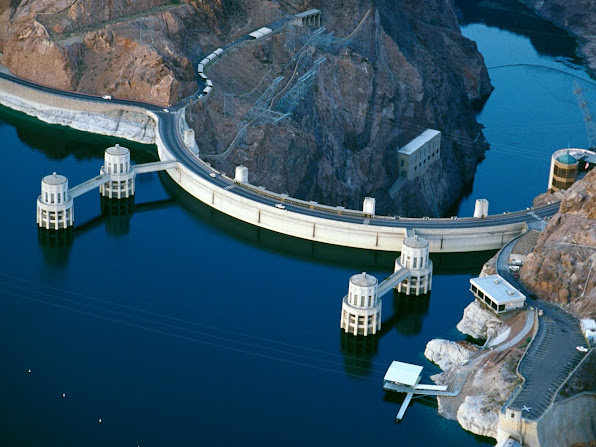Hoover Dam
Hoover Dam, formerly known as Boulder Dam, is a dam on the Colorado River in Black Canyon, Arizona, near the Nevada border. It is the highest concrete arch dam in the US and was built between 1930 and 1936. It impounds Lake Mead, one of the biggest man-made lakes in the world that stretches 115 miles (185 km) upstream. The dam provides residential water supply, hydroelectric electricity, agricultural irrigation, and flood and silt management. With almost seven million visitors a year, nearly one million of them take excursions inside the dam, it is also a popular tourist destination.
Hoover Dam measures 1,244 feet (379 meters) in length and 726 feet (221 meters) in height at its crest. Concrete in the volume totals 4,400,000 cubic yards (3,360,000 cubic metres). Water from the reservoir is diverted into enormous steel pipes called penstocks by four reinforced-concrete intake towers that are placed above the dam. Following a 500-foot (150-meter) drop via the pipes to the hydroelectric power plant at the base of the dam, the water rotates 17 Francis-type vertical hydraulic turbines, which drive a network of electric generators with a 2,080-megawatt capacity.
Colorado River
The Metropolitan Water District of Southern California, the city of Los Angeles, and other southern Californian locations receive almost half of the electricity produced; the remaining percentage is sent to Nevada and Arizona. The U.S. Department of the Interior's Bureau of Reclamation is the owner and manager of the dam, power plant, and reservoir.
The dam is named after Herbert Hoover, a U.S. president whose term (1929–1933) saw the start of construction on it and whose work as commerce secretary in the 1920s helped to secure the required agreements for the project to move forward. The construction of the dam, a significant undertaking that involved thousands of employees and took place during the Great Depression, resulted in almost 100 fatalities. Although Hoover's name was given to the project by legislation approved by Congress in 1931, authorities in the administrations that followed Hoover's, Franklin D. Roosevelt and Harry S. Truman, referred to it as Boulder Dam, its pre-construction designation. A congressional resolution returning the formal name of the building to usage was signed by Truman in 1947.
Since the dam's construction, a federal roadway has run along its crest, providing access to both Nevada and Arizona as well as tourists to the dam. The popularity of the Lake Mead recreation area and the dam led to an increase in traffic, which was made worse by the security measures put in place following the September 11 attacks. In October 2010, a concrete arch bridge with a 1,060-foot (322-metre) span—the largest in North America for that type of bridge—opened for through traffic within view of Hoover Dam. Construction on the long-planned Hoover Dam Bypass Project started in January 2005. Visitors visiting the dam are only permitted to utilize the old road along the summit.
More Information About Hoover Dam
On the boundary of the American states of Nevada and Arizona, in the Black Canyon of the Colorado River, sits the Hoover Dam, a concrete arch-gravity structure. It was built during the Great Depression between 1931 and 1936, and President Franklin D. Roosevelt dedicated it on September 30, 1935. Over a hundred lives were lost during the huge effort that went into building it, which involved thousands of employees. In legislation enacted by Congress during its construction, it was referred to as Hoover Dam in honor of President Herbert Hoover, but the Roosevelt administration renamed it, Boulder Dam. Congress reinstated the Hoover Dam name in 1947.
The Black Canyon and the adjoining Boulder Canyon have been under consideration for their ability to build a dam that would manage floods, supply irrigation water, and generate hydroelectric power since about 1900. Congress gave the project the go-ahead in 1928. Six Companies, Inc. made the successful bid to construct the dam, and work on it got underway in early 1931. Some of the construction methods had never been used on a concrete structure of this size previously. Additionally, challenging factors included the hot summertime climate and the scarcity of facilities close by. Nevertheless, more than two years ahead of schedule, on March 1, 1936, Six Companies handed the dam over to the federal government.
The largest reservoir in the United States by volume when full is Lake Mead, which is dammed by Hoover Dam. The dam is located about 30 miles (48 km) southeast of Las Vegas, Nevada, close to Boulder City, Nevada, a community that was first built for employees on the construction project. Public and private utilities in Nevada, Arizona, and California are powered by the dam's generators. Seven million people visit Hoover Dam each year, making it a popular tourist destination. Before the Hoover Dam Bypass opened in October 2010, the extensively used U.S. Route 93 (US 93) followed the dam's crest.
The Colorado River was considered a potential source of irrigation water when the United States built the Southwest. In the late 1890s, land developer William Beatty constructed the Alamo Canal just north of the Mexican border. The canal dipped into Mexico before heading to a desert region Beatty termed the Imperial Valley. This was the first attempt to redirect the river for irrigation purposes. Although the Imperial Canal's water supply made it possible for the valley to be widely settled, maintaining the canal proved to be expensive. The Southern Pacific Railroad spent $3 million in 1906–07 to stabilize the river following a catastrophic break that resulted in the Colorado River filling the Salton Sea, a sum it had anticipated in vain would be compensated by the federal government.
Lower Colorado was taken into consideration for its hydroelectric power potential as electric power transmission technology advanced. The Edison Electric Company of Los Angeles examined the river in 1902 with the intention of constructing a 40-foot (12 m) rock dam with a 10,000 horsepower capacity (7,500 kW). However, there were few customers (mainly miners) within that limit at the time because the distance for electric power transmission was limited to 80 miles (130 km).







0 Comments